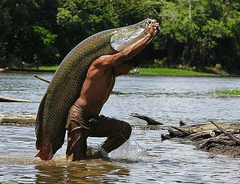Salmon & Pirarucu Fish Leather
Pirarucu: a luxurious and ecological material
The pirarucu (Arapaima gigas) is the largest scaled freshwater fish in the world, reaching to over 3 m in length and to over 220 kg in weight. It is found across the Amazon Basin.
 Over the last 20 years, Brazil has adopted a pioneering approach to pirarucu management based on supporting community rights to establish rules about access, to exclude other users from protected lakes, to monitor pirarucu populations, and to fish the species under government-approved quotas.
Over the last 20 years, Brazil has adopted a pioneering approach to pirarucu management based on supporting community rights to establish rules about access, to exclude other users from protected lakes, to monitor pirarucu populations, and to fish the species under government-approved quotas.
This approach was based on the recognition that giving local people an incentive and a role in management could strengthen local monitoring and rule compliance and reduce overall conservation costs, while generating important local livelihood benefits.
Community-based pirarucu management involves the communities residing in sustainable-use protected areas, on indigenous lands, and other areas subject to state-recognized fishing agreements.
It is made possible through the development and scientific verification of community monitoring of pirarucu.
The pirarucu management project began in 1999 with the goal of recovering the fish stock, in order to provide food security to the local residents. The project started with only one conservation unit authorized to work with fishing of pirarucu. Since then, the interest of other areas has grown and in 2018, 33 areas were issued with authorizations to catch pirarucu.
Pirarucu provides a variety of products, with the meat, the skin, the scales, and the tongue all commercialized. Both meat and skin products from community-managed wild sources are exported to international markets, with the skin being the most important export. The skin is used for exotic leather products, including shoes, bags and clothing.
Key livelihood benefits for rural communities from involvement in management and trade of pirarucu are food security and income. These benefits are crucial to the rural communities that harvest pirarucu, who typically have no or very minimal other opportunities to generate cash income.
Community-based management of pirarucu, based on sustainable harvest and trade, is an outstanding conservation success story. Widespread and rapid recoveries of pirarucu have taken place in areas with community management in place.
Comparing the first and last years of management at each lake, population sizes increased by over 200% in the lakes that were protected by communities and subject only to harvest of pirarucu.

Salmon Leather: a sustainable and exotic material for the future

Salmon leather is a premium option for making quality leather goods. Made from salmon skin, which is a by-product of the fish processing industry, salmon leather is therefore a repurposed material that would otherwise be discarded.
There are many qualities that make salmon leather ideal in performance and aesthetic. It is stronger and more flexible than its cow leather counterpart, yet is softer, and comparable in texture as snakeskin leather.
What makes salmon leather stronger and more durable is that it has a natural cross-fiber structure unlike the fibres in cow leather, which only run in one direction.
Though the industry has had an enthusiastic resurgence as of late, the practice of making fish leather clothing is ancient. Hunters and gatherers in Iceland would make shoes out of fish skin by scraping the skin off, stretching and cutting the material accordingly, then drying the material on the feet of the person who would wear the shoes.

The Hezhe ethnic tribe, or Nanai people, of the Far East, is known as “the fish leather tribe”, for they mostly subsisted on fishing and would make their traditional clothes out of fish leather. Some of the earliest accounts of the Hezhe culture date back to the 18th century.
Sourcing and tanning
We source our Pirarucu and Salmon leather from a supplier in Brazil, who is acknowledged to be a true pioneer in the field of organic, metal-free tanning, Our supplier combines a refined aesthetic taste with the utmost respect for the surrounding ecosystem and environment.
They process only tracked and regulated skins from suppliers that maintain international sanitary regulations and well-being practices, helping protect the fish, fishermen families and nature itself.
The tanning and dyeing uses zero heavy chemicals, environmentally safe-based on a blend of biodegradable acrylic resins, polymers, glutaraldehyde, synthetic & vegetable tannins.
The water that runs out of the tannery after treatment goes straight to irrigation without any negative impact on the environment
Sources:
- Harvest and trade of pirarucu in the Brazilian Amazon, CITES & Livelihoods, Case Study 2019
- SynZenBe Magazine, Susana Aguirre, 2015
- Meet the fish leather pioneers, Beth Timmins, BBC News, 2019
